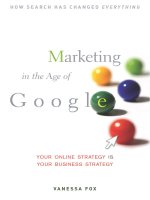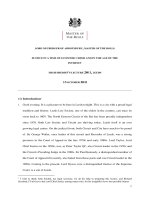Marketing in the Age of Google : Your Online Strategy IS Your Business Strategy
Bạn đang xem bản rút gọn của tài liệu. Xem và tải ngay bản đầy đủ của tài liệu tại đây (5.38 MB, 245 trang )
Copyright # 2010
by Vanessa Fox. All rights reserved.
Published by John Wiley & Sons, Inc., Hoboken, New Jersey.
Published simultaneously in Canada.
No part of this publication may be reproduced, stored in a retrieval system, or transmitted in any
form or by any means, electronic, mechanical, photocopying, recording, scanning, or otherwise,
except as permitted under Section 107 or 108 of the 1976 United States Copyright Act, without
either the prior written permission of the Publisher, or authorization through payment of the
appropriate per copy fee to the Copyright Clearance Center, Inc., 222 Rosewood Drive, Danvers,
MA 01923, (978) 750 8400, fax (978) 646 8600, or on the Web
at www.copyright.com. Requests to
the
Publisher for permission
should be addressed to the Permissions Department, John Wiley &
Sons, Inc., 111 River Street, Hoboken, NJ 07030, (201) 748 6011, fax (201) 748 6008, or online at
/>Limit of Liability/Disclaimer of Warranty: While the publisher and author have used their best
efforts in preparing this book, they make no representations or warranties with respect to the
accuracy or completeness of the contents of this book and specifically disclaim any implied
warranties of merchantability or fitness for a particular purpose. No warranty may be created or
extended by sales representatives or written sales materials. The advice and strategies contained
herein may not be suitable for your situation. You should consult with a professional where
appropriate. Neither the publisher nor author shall be liable for any loss of profit or any other
commercial damages, including but not limited to special, incidental, consequential, or other
damages.
For general information on our other products and services or for technical support, please contact
our Customer Care Department within the United States at (800) 762 2974, outside the United
States at (317) 572 3993 or fax (317) 572 4002.
Wiley also publishes its books in a variety of electronic formats. Some content that appears in print
may not be available in electronic books. For more information about Wiley products, visit our Web
site at www.wiley.com.
Library of Congress Cataloging in Publication Data:
Fox, Vanessa, 1972
Marketing in the age of Google: a non technical guide to search engine strategy / Vanessa Fox.
p. cm.
Includes bibliographical references and index.
ISBN 978 0 470 53719 0 (cloth)
1. Internet marketing. 2. Internet searching. 3. Web search engines. I. Title.
HF5415.1265.F678 2010
658.8
0
72 dc22
2009047256
Printed in the United States of America.
10987654321
Contents
Foreword DANNY SULLIVAN xi
Preface xiii
1
How Search Has Changed Your Business 1
2 How to Use Search Data to Improve Your Business
and Product Strategy 27
3 How We Search 63
4 Building Searcher Personas:
Opening the Door to the Crowd of
Customers You’ve Been Keeping Out 83
5 How Search Engines Work 111
6 Implementing an Effective Search Strategy 137
7 Working with Developers: How to
Turn Business Strategy into Tech Speak 155
8 How to Cut through the Data and
Get the Actionable Metrics You Need 171
9 Social Media and Search 185
10 What’s Next?: Beyond Google and 10 Blue Links 207
ix
Notes 219
References 231
Index 233
x CONTENTS
Foreword
There’s a special place where customers gather each day, willingly seek-
ing businesses that can help them. They want cars. They want plumbers.
They want music downloads. They want vacation rentals, lawn care
products, tax advice and more. You name the product or service, this
place has someone looking for it.
This venue is the ultimate destination for those after a prequalified
audience. Everyone there is ready to buy or convert in some way. Every-
one is explicitly asking to be contacted. Everyone is even willing to take
part in market research to help guide a business forward. Here’s the best
part: As a business, it costs nothing to be admitted.
What’s the catch? There isn’t one, other than being aware of the
opportunity this place provides and tapping into it.
The place? The major search engines used by millions each day.
Yahoo!, Microsoft’s Bing, and the largest of them all, Google. Consum-
ers increasingly depend on these tools to locate products, services and
information. Search engines continue to usurp more ‘‘traditional’’ means
of reaching customers, such as newspapers, phone books, or television.
But unlike those traditional means, getting in front of consumers
through search engines doesn’t require a huge marketing budget.
Search engines mine web pages and other digital content to auto-
matically provide answers to those searching. Becoming one of those
answers can require no work at all. Many companies just naturally turn
up in the search listings—for free.
xi
With a little savvy, companies can increase their representation.
Have you thought about the exact ways people might be searching for
your goods? Have you ensured that search engines can properly read
your Web site? Have you considered how you’re listed beyond your
Web pages, in areas such as video results?
The hardest part of success with search engines isn’t the tactical
changes or techniques involved. It’s simply becoming ‘‘search aware’’ in
the first place—of understanding the importance of search and ensuring
that you’re not ignoring easy-to-take opportunities or establishing barri-
ers that block your potential.
That’s where this book comes in. It will help you over that hardest
part: gaining search awareness. In it, Vanessa Fox illustrates the impor-
tance of search for today’s marketer. She breaks down search marketing
into common sense components that won’t make you feel lost in jargon
or tactics.
I’ve written about search marketing for nearly 15 years now, and it
still amazes me that more people still don’t understand the incredible
value it holds. Discover the importance of search in this book, how it can
help you reach your customers and discover new directions to take your
business. Read on about the new age in marketing—that of Google and
search engines.
—Danny Sullivan, Editor-in-Chief,
SearchEngineLand.com
xii FOREWORD
Preface
When I worked at Goo gle, I talked to thousands of business owners
seeking my help and advice. To them, Google was somewhat of a black
box. They knew that organic search (the unpaid result set) was impor-
tant, but they had no idea how to use search data and customer acquisi-
tion from organic search in their business processes.
We built Google Webmaster Central
1
as a w ay to give business
owners and Webmasters insight into how their sites were performing in
Googleandtohelpthemidentifyproblemsandmakeimprovements.
During my tenure at Google and since, the business owners I talk to
often fall into one of the following camps:
Those who know search has become an important pa rt of the
customer engagement cycle, but aren’t sure where to start.
Those who don’t think search is that important and believe that
even if it is, businesses shouldn’t have to concern themselves with
it. It’s Google’s job to sort things out.
Those who get so caught up in optimizing their sites and ranking
number one that they don’t step back to look at the bigger pic-
ture: to understand how searchers behave, how to engage w ith
them, and how to turn them into lifelong customers.
After I left Google, I wanted to take what we started with Webmaster
Central and go beyond helping people pinpoint issues that might be pre-
venting them from doing well in search. I wanted to help them fix those
xiii
areas, improve their sites, and take the focus off of ranking and put it on
connecting with the right audience. In short, I wanted to change the con-
versation about search. I wanted to help businesses understand why
organic search was important to their long-term success and show them
how to harness it for better customer engagement, more informed business
and product strategy—and introduce them to a whole new world of
customers who they may have been missing. Thus, the idea for this book
was born.
If you’ve picked up this book, you already realize that search is be-
coming the primary way in which many people get information, decide
what to buy, and make those purchases. And you know that as customer
behavior changes, businesses remain successful by changing with them.
These days, your search strategy is your business strategy, whether
you realize it or not, because that’s how potential customers are trying to
find you. Search is the new Yellow Pages, 800-number, Sunday circular,
card catalog, and cash register.
But how do you build a comprehensive search strategy? And how
can you take advantage of the amazing amounts of data that search
makes available about your potential customers? Much as our evolution
to a searching culture was a fundamental shift in behavior, fully realizing
the potential of search often requires such a shift in your business. This
adjustment will help you better connect with potential customers, make
more informed business decisions, and remain relevant as our world con-
tinues to change. This book will get you there.
xiv PREFACE
1
CHAPTER
How Search Has Changed Your Business
Twenty years ago, the World Wide Web as we know it today didn’t
exist. Ten years ago, only early technology adopters used search engines,
and Google was a struggling young upstart. Now, over 50 percent of on-
line Americans use search engines every day and over 90 percent of them
use search engines every month. That’s a lot of potential customers who
are looking for you and a lot of market research about what those cus-
tomers want.
Americans conduct 22.7 billion online searches a month
1
and
worldwide, we type into a search box monthly 131 billion times. That’s
29 million searches per minute.
2
It’s safe to say that we’ve become a
searching culture. Just take a look at the 2009 Super Bowl to see this in
action. Look at the spiking searches on Google the morning of the big
game. Thirty-five of the top 100 have the word ‘‘Super Bowl’’ in them,
and another 27 are Super Bowl–related (see Figure 1.1).
3
Business leaders know that the world is changing. More customer
research and transactions take place online now than ever before, and
those numbers are only going to increase. Globally, the number of
searches grew 46 percent in 2 009. Accordi ng to Jack Flanagan, com-
Score executive vice president, ‘‘Search is clearly becoming a more ubiq-
uitous behavior among Internet users that drives navigation not only
directly from search engines but also within sites and across networks.
1
If you equate the advancement of sea rch with the ability of humans to
cultivate information, then the world is rapidly becoming a more knowl-
edgeable ecosystem.’’
4
But many professionals simply aren’t sure how to
evolve their businesses to best take advantage of this changing landscape.
This book will show you how to think about your business in a new way,
to better connect with your customers through search, and to weave the
value that search provides into all aspects of your organization.
Through organic search, you can reach potential customers at the
very moment they are considering a purchase and provide them informa-
tion exactly when they are looking for it. While many businesses are at-
tempting to connect with their potential customers through paid search
(such as with Google AdWords), the opportunity to reach these custom-
ers through organ ic searc h—the results that are algorithmically gener-
ated rather than paid for—remains largely untapped. In fact, 88 percent
of online search dollars are spent on paid results, even though 85 percent
Figure 1.1 Google Search Trends, Super Bowl 2009
Source: Google Trends
2 MARKETING IN THE AGE OF GOOGLE
of searchers click on organic results.
5
Search is a fairly unique opportu-
nity to connect with your potential customers.
Never before have we had access to such remarkable amounts of
data about potential customers. We know what they search for (and
what they don’t). We know how they shop and how they buy. We can
even find out where they look on a page. Businesses spend such signifi-
cant amounts of time and money on market research, focus groups, and
usability studies, yet so many fail to augment this information with the
abundance of free data available from those 113 billion searches a month.
We don’t have to look farther than our local newspapers to see how
consumer behavior has changed. The newspaper indu stry spent years
trying to get readers to return to their old behaviors of expecting the
newspaper at their doors every morning, and reading the stories as they
were laid out in print. But those readers had moved on to searching on-
line for news on topics of interest and getting that information in real
time rather than a day late. Similarly, companies have to adapt and
evolve with their customers instead of attempting to get their customers
to return to their old ways.
Doesn’t Google Show the Most Relevant Sites
to Searchers
Without
My Input?
I was recently talking to Wired magazine senior writer Steven Levy (pre-
viously the senior technology editor for Newsweek), who’s been spending
a lot of time at Google researching his book, Searching for Google.
6
Levy
doesn’t believe that businesses should have to do anything ‘‘special’’ to
their sites for Google since Google’s purpose is to surface the most rele-
vant, useful results to the top. He compares the practice of site owners
trying to influence this to students having coaches for the SAT exam.
I told him I didn’t see things that way at all. I see the situation as
similar to a retailer who o pens a st ore in a new city. Before leasing a
building, they’ll likely scout out the area to find the best corner. They’ll
do some competitive research to see where the o ther retailers are
located, as well as some customer research to see where their target con-
sumers shop. (Many even stand on sidewalks and count people walk-
ing by!) Retailers know that even if their store has the most amazing
How Search Has Changed Your Business 3
merchandise at super low prices, they might not have many customers if
they open their store in an alley that’s closed to traffic and they don’t let
anyone know they’re there. John Deere probably wouldn’t have many
people buying riding lawn mowers in a store in Manhattan.
Companies should think of their online presence as another ‘‘retail
location.’’ Organic search is the city they’re in, the street they’re on, the
sign above their door. John Deere opens stores in towns where people
have really big lawns, and they keep the doors unlocked so their custom-
ers can get in. If you don’t do the same with organic search, you’re miss-
ing an increasingly large percentage of your potential customers.
The Keys to an Effective Search Strategy
To incorporate search into your organization:
Add search metrics to your data mix to better understand your
audience, see industry trends, and build a better product strategy.
Integrate offline and online marketing activities to capitalize on
your offline advertising efforts and to keep from losing potential
customers that your offline advertising efforts are driving to
search engines.
Develop a search acquisition strategy that fully harnesses the
searching behavior of your potential customers.
To successfully execute your search strategy, you should build its
importance into every aspect of the organization—not just marketing.
A suc cessful search strategy depends on IT and Engineering, Product
Marketing, Business De velopment , Marketing and Advertising, P R,
Customer Su ppor t, User Research, User Int eract ion Design, a nd a ny
other department that thinks about the business, customers, product, or
Web site. Marketing in the Age of Google will guide you toward building
a succ essful search strategy and ex tending the process for ex ecution
throughout your entire organization.
This book talks about organic search—the search results that are
generated algorithmically based on what the search engines think is
most relevant for the query. Paid search (the ads that appear beside the
4 MARKETING IN THE AGE OF GOOGLE
organic results) is also an important piece of the search strategy puzzle
but a number of resources exist to help businesses better understand and
use paid search so in this book we’ll only be talking about it as it influ-
ences organic search.
What is your organic search strategy? If you don’t have one, you’re
missing a key piec e of your business strategy—and shutting out many
potential customers who are looking for your business. If you’re an exec-
utive, this book will give you a holistic view of how search fits into your
overall business strategy and how to integrate it into the organization. If
you’re a marketer, developer, user interaction designer, or other wise
work on customer engagement, product development, or company
awareness, this book will show you how to incorporate search into what
you’re already doing for an even better return.
Search as the Entry Point of the Web
For many of us the search box has become our entry point to the Web.
When the Web first gained popularity, it became important for a busi-
ness to have a Web site. As online activity became more prevalent, it be-
came important for a business to include a domain name in advertising
and other materials. Now things have shifted again, and it’s vital for a
business to rank well in search results both for their brand name and for
queries relevant to the business.
But integrating offline and online marketing is only half the story.
It’s just as important to understand the needs of your customers. For
years, compa nies have commissi oned focus groups and large-scale sur-
veys and conducted massive market research to find ou t what their
potenti al customers want and how their current customers think about
them. All of those activities are still valuable, but there’s now an easier
(and cheaper) way. Search can provide powerful data about exactly what
your potential customers want and what they’re thinking about you.
Every Day, Millions of Potential Customers Are Telling You
Exactly What They Want
Intuit sells accounting software. Their product packaging, ma rketing
materials, and Web site all refer to this software as bookkeeping
How Search Has Changed Your Business 5
applications. But if you take a look at what their potential customers are
searching for, you’ll notice that it’s ‘‘accounting’’ over ‘‘bookkeeping’’
software by a substantial margin. (You’ll learn how to find out how your
customers are searching for you in Chapter 2.) See Figures 1.2 and 1.3.
Not only is Intuit missing this audience from its search acquisition
funnel, it’s not resonating with its potential customers as well as it could
be in offline channels.
The National Institutes of Health (NIH) has an important mission
to make accurate and useful health-related information available to the
American public but limited resources with which to do so. If this group
wants to help the greatest number of pe ople first, it could st art with
search data. You can see below that many more people are looking for
information on arthritis than on heart disease. See Figure 1.4.
Figure 1.2 [Accounting] and [Bookkeeping] Search Volume
Source: Google Trends
6 MARKETING IN THE AGE OF GOOGLE
Figure 1.3 Speaking the Language of Your Customer
Source: Google Trends and Quickbooks.Intuit.Com
Figure 1.4 [Arthritis] and [Heart Disease] Search Trends
Source: Google Insights for Search
How Search Has Changed Your Business 7
Diving deeper, we can see that ‘‘rheumatoid’’ is the type of arthritis
that people search for the most and that Ohio’s population has one of the
keenest interests in this topic. See Figures 1.5 and 1.6.
Many factors go into prioritizing projects, but your potential audi-
ence’s primary interest can be a valuable one.
Whether you run an online business, a multinational conglomerate
with no online pres ence, or a two-person s tartup out of your ga rage,
your customers are providing you with valuable data that can help form
your business strategy.
Figure 1.5 [Arthritis] Search Trends
Source: Google Insights for Search
Figure 1.6 [Arthritis] Regional Search Trends
Source: Google Insights for Search
8 MARKETING IN THE AGE OF GOOGLE
How Search Has Changed Marketing
As defined by the Chartered Institute of Marketing, mark eting consists
of ‘‘identifying, anticipating and satisfying customer requirements prof-
itably.’’
7
That definition doesn’t change as business moves online.
But while the core elements of marketing remain the same, it’s no
secret that consumer behavior is shifting. We frequently turn to online
sources for things we used to get offline—from news and local directo-
ries to televis ion shows, music, and movies. This evolution means that
the expectations of your potential customers and their methods of inter-
acting with you may be different than before. For instance, they may
expect support online, whereas before they may have looked for an
800-number.
This shift also means that traditional forms of ad vertis ing don’t
have the reach that they used to have. If 10 million fewer people a re
reading the printed newspaper in April, 2009 than April, 2008,
8
then
10 million fewer people are seeing your print ads. If people are throwing
away Yello w Pages books , then none of those people are se eing your
Yellow Pages directory listing.
9
Savvy marketers are transferring spending to online advertising—
particularly paid search—but they haven’t yet started to take full advan-
tage of the 85 percent of clicks that organic search produces.
Buyers Are Shifting to Searching
Our buying patterns are changing along with our online behavior.
10
Of
the 18 billion monthly U.S. searches, nearly 12 percent are retail-
focused.
11
United States census data from 2008 showed that e-commerce
sales reached $31.9 billion that year.
12
Market research company Forres-
ter estimates that the worldwide e-commerce market will reach $235 bil-
lion in 2009. Clearly, we’ve begun buying online. How do we get to
those e-commerce sites? In 2007, Microsoft internal research found that
86 percent of searchers start at a major search engine when shopping and
70 percent of those product-related queries are for categories, such as
[digital camera].
13
In part because search has become such a core way in which we
navigate the Web, the home page of a site may not be the entry point for
How Search Has Changed Your Business 9
a visitor. Any page ca n be the entry page, which makes it increasingly
difficult for marketers to craft messages that welcome visitors and com-
pel them through the conversion funnel. We have to rethink our
approach to site design and user interaction based on this new world.
(We’ll talk more about how to ensure every page of your site is a compel-
ling entry in Chapter 4.)
Even those r etaile rs who don’t sell products online or who ha ve
substantial offline sales are still impacted by search. Online advertising
triggers $6 to be spent offline for every dollar spent online
14
and the
in-store sales boost from search is three times greater than online display
advertising. Considering that those numbers were c alculated for paid
search, how much of a greater impact c an or ganic sear ch have with
85 percent of the clicks?
Sixty-three percent of search-related purchases occur offline,
15
and
for some categories , this number is even higher.
16
What about local
businesses? In a WebVisible/Nielson study, 82 percent of responden ts
said that they’ve used the internet to find local businesses; 80 percent say
they’ve researched a product or servi ce online before buying it locally.
Yet, only 44 percent of small businesses even have a Web site.
17
If you
have a business, you need to be visible in search engines whether you sell
online or not.
Paid Search Isn’t Enough
As already noted, companies can connect with searchers in two primary
ways: paid search and organic search.
Paid search consists of ads that adverti sers can buy to display to
searchers who type in particular queries. These ads are labeled ‘‘spo n-
sored’’ on the search results page. These ads can be very targeted (for
instance, an advertiser can show an ad that says ‘‘buy wool socks here’’ to
a searcher who types in ‘‘where can I buy wool socks?’’) and the order in
which the ads appear is based on a number of factors including the
amount the advertiser is willing to pay for each click, the relevance of
the ad to the query, and the quality of the page linked to in the ad.
Organic search, on the other hand, is comprised of result s that are
algorithmically generated. Search engines mine the Web, extract the
content, assign value and relevance to each page, and then r eturn and
10 MARKETING IN THE AGE OF GOOGLE
rank those pages for each query. See Figure 1.7. (You ca n learn more
about this process in Chapter 5.)
Businesses are becoming increasingly savvy about paid search. It’s a
measurable advertising mechanism by which you can track exactly how
much you’re spending and what the return is. However, many businesses
have not yet invested in organic search because they aren’t sure how it
works or how to measure it. But whatever the return you are getting
from paid search, your organic search return will be greater. And if your
site is visible in both paid and organic results, both strategies will provide
an even greater investment.
Let’s take a closer look at the numbers.
Organic Sea rch Performance
Not only do searchers click on organic results 85 percent of the time, an
organic listing is between two and six times more visible than a paid one.
One hundred percent of searchers look at the first organic result, while
only 50 percent look at the first paid result. As the rankings go down, the
gap widens: 50 percent of searchers see the seventh organic listing, but
only 10 percent of searchers see the seventh paid listing.
18
Even if you’re
Figure 1.7 Organic Search versus Paid Search
Source: Google Search Results
How Search Has Changed Your Business 11
looking for increased brand awareness rather than clicks, organic search
will provide a greater return.
In May, 2009, online intelligence-gathering group Hitwise reported
that paid search engine traffic to Web sites was down 26 percent from the
previous year, yet organic search traffic was up.
19
Research company com-
Score found that while 2009 U.S. search queries were up 68 percent over
the previous year, paid clicks had grown only 18 percent during that same
period.
20
In some cases, this was due to a reduction in paid search spend-
ing, but this was also the result of changing searcher behavior. Searchers
are typing longer queries that trigger fewer paid search matches and they
are increasingly recognizing the difference between organic and paid re-
sults and have growing ad blindness. Studies have also shown that search-
ers trust organic listings more than paid ones and that organic results are
perceived as most relevant.
21
Additionally, the increasing number of vid-
eos and images in search results draws the searcher’s attention away from
the paid search column.
One considerable advantage of investing in organic search is that
it continues to provide value over time, whereas paid search traffic
disappears as soon as you stop your spend . Fifty-six percent of Google
queries show no paid ads at all, so if you’re c ounting on paid search to
provide all of your visibility to searchers, you could be missing half
your a udience.
22
The Additional Lift of Ranking in Both Paid
and Organic Results
Numerous studie s have found that when a site is visible in both paid
and organic search results, both results receive more clicks than if
either appeared alone. This could be beca use seeing a brand in both
places reinforces the perception that the brand is reputable. It could
be because even if we don’t consciously process that we’ve already
seen the brand, it seems familiar and, thus, relevant when we see it a
second time. Whatever the reason, studies have found that click-
through ra tes, conversion rates, and revenue are all highe r when both
organic and paid listings appear for a search.
23
An iCrossing study
found that when a brand appears in both the o rganic and paid results,
the searcher clicked on that brand 92 percent of the time, compared
12 MARKETING IN THE AGE OF GOOGLE
to 60 percent of clicks when the brand appeared in only one location.
24
This study found the results show in Figure 1.8 when an organic search
component was added to an existing paid search campaign.
A Google-sponsored Enquiro brand study, which focused on con-
sumers in the early stages of purchasing a fuel efficient car who hadn’t
yet decided on a brand, found that:
Searchers who saw Honda in the top paid and organic result were
16 percent more li kely to think of Honda as a fuel efficient car
than when the brand didn’t appear in either place.
Searchers were 42 percent more likely to recall Honda when
the brand appeared i n both kinds of results versus just the top
organic listing.
Searchers who saw Honda in both organic and paid results were
8 percent more likely to have purchase intent toward Honda and
were 26 percent less likely to consider a Honda purchase if t he
brand appeared in neither spot.
25
Yo u Can Get Ahead of Your Competition by Focusi ng
on Organic Search
The numbers make one thing clear: organic search is a worthwhile in-
vestment. But whereas online ad spending continues to grow—at
$9.1 billion in 2007, and projected to reach $20.9 billion in 2013
26
—the
percentage spent on paid search has outpaced organic between 2004 and
2008 (organic search had 12 percent of marketing spend in 2004 and
Figure 1.8 iCrossing Study Adding Organic Search Components to a
Paid Search Campaign
Source: icrossing.com
How Search Has Changed Your Business 13
10 percent of marketing spend in 2008 at $1. 3 billion
27
). Chances are,
your competition isn’t yet taking full advantage of what organic search
can offer and you can take the lead here while they’re playing catch up.
Michelle Goldberg, a partner at venture capital firm Ignition
Partners, stresses the importance of organic search to the compani es
she funds:
Understanding the differences between paid and organic search and
implementing each correctly is critical to the success of an early
stage company. Paid search may provide immediate volume, but
only provides customers as long as the company pays for clicks. If not
done right, a company can spend $1.00 to make $0.95. Organic
searchisalongtermandgenerally much better margin solution.
The largest expense associated with organic search tends to be content
creation, which can have long term benefits for both search acquisi-
tion and overall customer engagement. Not only is focusing on con-
tent creation good for search, but it’s also good for users and the
business overall because you’re creating content that consumers find
valuable and that helps you build a more sustainable business over
time. I make sure every startup I work with has an organic search
strategy.
28
How Search Performan ce Can Impact O¥ine Ad Campaigns
Advertising (such as TV commercials, radio advertising, print ads, and
direct mail) will cause a certain number of potential customers to go into
your store, call you, or type your domain name into a browser, but more
often than not these days, those potential customers will search for more
information. Television commercials in particular can drive search traf-
fic, as over half of us watch TV and surf the internet at the same time.
29
Two-thirds of us are motivated to search due to an offline channel such
as a TV ad.
30
Offline advertising can drive searches for both the ad tag-
lines and the products themselves. For instance, Apple started airing
‘‘I’m a Mac’’ ads in 2006, and the search volume for the phrase has stead-
ily gone up ever since (see Figures 1.9 and 1.10).
If Apple had simply aired the commercials expecting consumers to
go directly to their stores, t hey w ould have missed the e ntire potent ial
14 MARKETING IN THE AGE OF GOOGLE
customer base of searchers. But these would-be consumers have a posi-
tive experience when they search, as Apple.Com is listed as the first two
results for [I’m a Mac] (see Figure 1.11).
However, not all companies enjoy such a successful integration of
TV commercials and organic search. During the 2009 Super Bowl,
Hyundai spent approximately $13.5 million on advertising by sponsoring
Figure 1.9 Apple’s [I’m A Mac] Commercial Reel
Source: Apple.Com
Figure 1.10 [I’m A Mac] Search Volume
Source: Google Insights For Search
How Search Has Changed Your Business 15
the pregame show and running ads throughout the game. Two of its
commercials centered on its new coupe (at $6 million for airing costs,
plus commercial production costs). It first appeared that Hyundai under-
stood how to integrate offline and online activities and recognized their
customers’ desire to interact with the company online. The ad showed
the car speeding around a racetrack with exciting imagery and video and
ended with a Web site: edityourown.com. See Figure 1.12.
Figure 1.11 Google Search Results: [I’m A Mac]
Source: Google Search Results
Figure 1.12 Hyundai ‘‘Edit Your Own’’ Commercial
Source: Personal Screencap
16 MARKETING IN THE AGE OF GOOGLE









